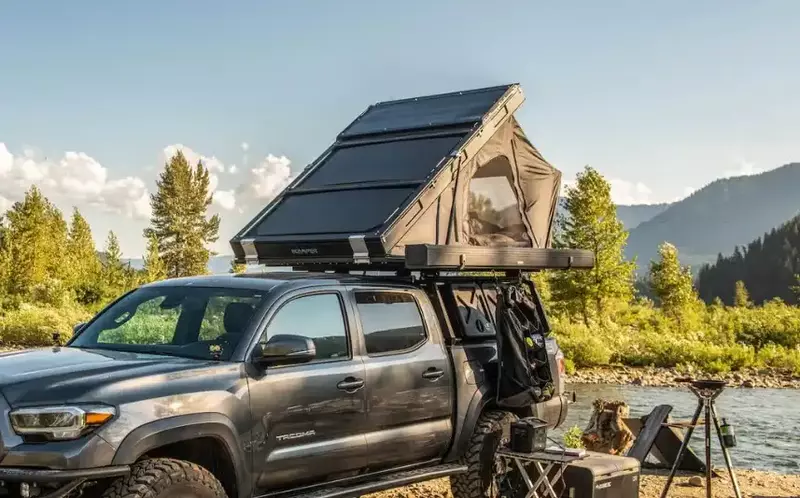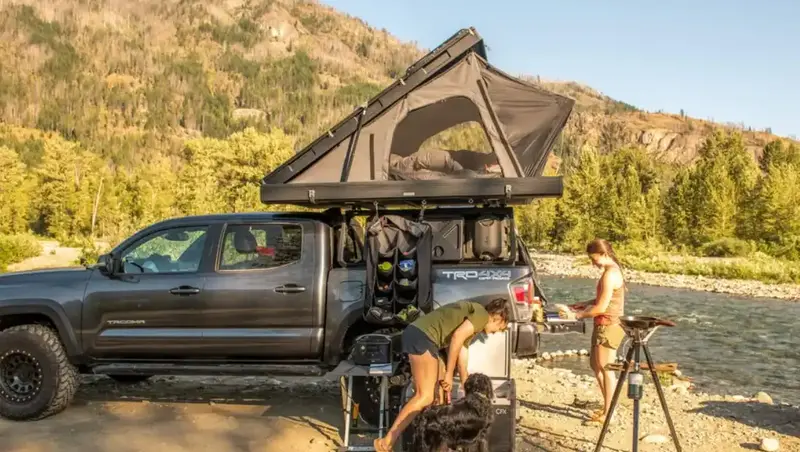There are several types of roof top tents on the market and all of them normally have a mattress inside that stays there when the structure is closed for transportation. But with bedding, the situation is a bit different.
The short answer to the question in the title is the following. From what one can see currently on the market the situation is this:
- Hard shell roof top tents are designed so that your blankets and pillows can remain there when the shelter is closed.
- Soft shell roof top tents cannot be closed together with blankets and pillows inside.
Hard shell roof top tents and bedding
There are essentially two types of these hard shell shelters:
Pop up roof top tents
The pop up hard shell roof top tents have quite enough space inside for bedding. This is not so surprising because they are usually not very thin when closed.
When you close it for transportation, the roof becomes the lid of such a solid box, and it is usually moderately aerodynamic. So overall performance is not bad.
You can see good examples in my comparison text with TentBox Classic and Venture Forward Hard Shell Rooftop Tent. The thickness of the box is respectively, 13.8 inches (35 cm) and 11.6 inches (29 cm).
Now, they look thin, but wait to see more below. In any case, you have a mattress inside, and the box is wide and long, so there is plenty of space for all the bedding that you normally need inside.
Clamshell roof top tents
This type is quite different in many ways. A detailed comparison between them and the pop-up type mentioned above is available here in the site so just follow the link to see how they compare.
There are some sub-types in this clamshell group, non-expandable and expandable, and you should know that the former is among the thinnest you will find.
One great example pf non-expandable type is the TentBox Cargo, you can see it in the video below. It is indeed easy to get delighted with this shelter, it is only 8.3 (21 cm) thick when closed.
Compare this with the pop-up models discussed above. And your bedding together with the mattress is there. Now, isn’t this impressive?

But how about the thickness of mattresses?
The integrated mattress in the mentioned iKamper BDV is 2.75 inches (7 cm). But in both models of the TentBox brand, the mattress is 2.4 inches (6 cm). So none of them is very thick.
However, in the TentBox Classic you have far more volume inside to add something extra if you need it, or to replace the existing mattress with a thicker one.
So as you see, the point is that mattresses are not thick enough to eventually downgrade to something thinner and to create space for bedding.
How about bedding in expandable clamshell roof top tents
This is a type that extends on the side of the car, and for transportation this all folds inside together with the ladder. And bedding? So yes, it can remain inside.
But these shelters are thicker than the simple clamshell type presented above. Here is one example, the iKamper Skycamp 3.0 Mini is 13.5 inches (34 cm) thick. So it is in the rank of the pop-up type roof top tents.
It is best to see this in the video, please have a look, it is at 4.16:
Soft shell roof top tents and bedding
As mentioned above, with soft shell roof top tents the situation is different. You have mattress inside, but there is no place for bedding.
These shelters normally always fold together with the mattress, and you probably know that a folded mattress may become bulky. So there is no place for blankets.
They could make the cover transportation sleeve larger to add blankets, but my guess is they don’t do this to avoid extra bulk.
Final thoughts
In summary, if you want to keep bedding inside of your roof top tent, you will have to go for a hard shell type. This may change in time, this industry is growing and technology is improving, but this is the situation now.
Among hard shell type roof top tents, there are big differences in the design and in the thickness when closed. This may be important for several reasons. Fuel consumption is definitely one of them.
But note also that some of them have options to attach additional racks on top of its box so you can transport more stuff on the roof of the roof top tent.
Bookmark this site and keep as a references, you will always have fresh news here from this industry. Thank you for reading.

 Hi, I am Jovo, the founder of this Off-Ground Tents site and several other outdoor sites. I have been mountaineering for almost 40 years already, and I have created this site to use as a reference for various types of above ground tents.
Hi, I am Jovo, the founder of this Off-Ground Tents site and several other outdoor sites. I have been mountaineering for almost 40 years already, and I have created this site to use as a reference for various types of above ground tents.